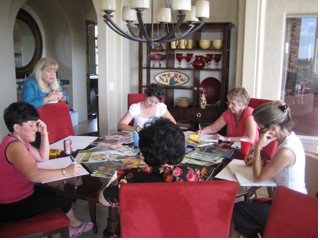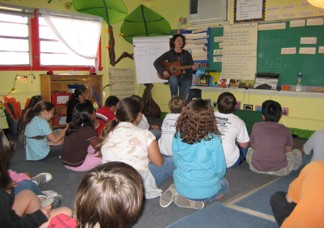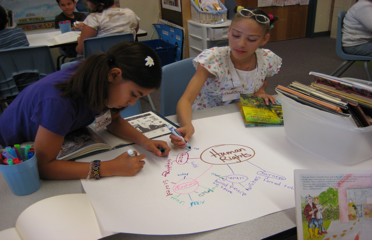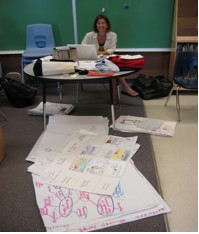Practice Makes Perfect in Our Community of Practice
by Amy Edwards, Fifth Grade Teacher, Van Horne Elementary
The beginning of a new school year found us gathering as teachers in a retreat to think about possible themes to frame our work. Three new teachers were joining our study group of eight returning teachers along with our principal, instructional coach, counselor, and a university researcher. As we webbed ideas that would take us to our central theme for the fall, it became clear by the looks on the newcomers’ faces that they thought we were speaking some sort of unknown language. We were quickly brainstorming ideas and responding to each other’s suggestions with ease. They, on the other hand, were staring straight ahead, mouths slightly open, trying to figure out what we were doing. They did not have a context for our talk and thinking and sat at the edge of our community trying to figure out our practice.
I love teaching at Van Horne. We are lucky to have a working environment where teachers continue to learn together as they teach. It is an environment of focus, risk taking, support, trust, and respect. What we have created together is a unique professional learning community because our collective efforts are related to the practice of how we do school, with teachers and students alike. Our work is not just theory, but a reality of our everyday lives.
Lave and Wenger (1991) refer to these relationships and interactions as a community of practice. Communities of practice are based in the belief that knowledge is situated in experience and that experience is understood through critical reflection with others who share this experience (Buysse, Sparkman, & Wesley, 2003). We are using this framework successfully because of the participation of teachers and students. Lave and Wenger (1991) state that learning is not in individual heads, but in the process of co-participation; participation is a way of learning. Their description of communities of practice in the working world are more closely aligned with what we do at Van Horne than what educators routinely call a professional learning community or PLC.
The term PLC is used loosely in many schools and has become a buzzword thrown around to mean different things. On one end of the spectrum there are faculties that think teaching in the same building or sharing the same group of students makes them a professional learning community. Many schools use this term to describe grade level meetings where teachers look at test scores, student work, or the sequence of curriculum.
Teachers at Van Horne understand that their learning as professionals needs to directly involve learning with their students. Our professional learning is social, contextual, and personal. The relationship between teaching and learning is interdependent because what comes next in our learning depends on the understandings of everyone involved, students and faculty. It is a symbiotic relationship in that the teachers need the thinking of the students and students need the thinking of teachers for learning to move forward as we “practice” together. This participation framework works well because we are moving forward in our understandings through situational learning, instead of just covering the mandated curriculum. The learning that takes place for teachers becomes part of student experiences and provides a context for future learning. Stein (1998) states that situational learning is associated with three major premises:
- 1. Learning is grounded in daily activities and cannot be separated from the complex environments in which knowledge must be applied.
2. Knowledge is acquired through experience and transfers only to similar situations.
3. Learning is the result of social processes that require negotiation and problem solving with others.
Situated learning shifts the analytic focus from “the individual as learner to learning as participation in the social world” (Quay, 2003, p. 105). Situated learning accounts for the complex role that context plays in learning. Instead of learning about a particular type of curriculum, we are engaging in practice about the learning. What we know is directly related to our actions and on our reflections about those actions. Learning is a way of being in the social world, not a way of coming to know about it (Lave & Wenger, 1991).
A central defining characteristic of situated learning is a process called legitimate peripheral participation (Lave & Wenger, 1991). Learners inevitably participate in communities of practitioners and the mastery of knowledge and skill requires newcomers to move toward full participation in the sociocultural practices of the community. This allows for communication between newcomers and old-timers about activities and knowledge within that community. Learners enter the community at the periphery and over time move closer to full, legitimate participation as they gain knowledge and learn the community’s customs and rituals (Buysse, Sparkman, & Wesley, 2003, p. 265). As new teachers joined our group this year, the natural tendency was for them to remain on the edges of learning about our inquiries. As they participated with the old-timers, they gained new knowledge and insights to grow as learners and to eventually fully participate in our community. A community of practice is comparable to the old system of apprenticeship. We witnessed this same growth with children as well in their learning. For them, life is their apprenticeship.
I have previously been part of a professional development program that included a fabulous year of training outside the classroom run by gifted presenters. While they used wonderful examples of how to implement these ideas in our classrooms, there was one problem. I was expected to bring this information back to my staff using the Trainer of Trainers method. It was a disaster. There was not enough time for me to feel proficient enough to present this new information to my colleagues without having time to first try it out with students. Even with a couple of demonstrations with students, I didn’t feel proficient enough to explain the instructional strategies in depth. The presenters went to great lengths to have us outline when and where we were going to present this information to our staff in professional development settings. My learning was decontextualized and not part of a community of practice. It was not based on experiential learning or legitimate peripheral participation that would have allowed me to get comfortable with the methods or materials being taught. I was supposed to watch the presenters and then do it back at my school, nevermind thinking critically about it or trying to put it into a context. The Trainer of Trainers method left me feeling frustrated and like I just didn’t get it.
One of the biggest benefits of working within Van Horne’s community of practice is the support we receive from one another. Not only are we supported by our administration, but also by other teachers, our facilitator, Lisa Thomas, and Kathy Short, a researcher from the University of Arizona. We have a certain amount of accountability and responsibility to each other due to the learning we and our students are experiencing, but also our sense of contributing to the field through our research. No one wants to be absent or have a schedule conflict on Thursdays because that’s the day Kathy is in the lab and study group.
Because of the respect we have for our peers, there is a strong sense of not wanting to let each other down. Our work encourages accountability and responsibility to each other in our community of practice. There is also an understanding of the strong underlying work ethic that is necessary for this important project. Participation in this venture is voluntary as an invitation to learn. We are members by choice, not because we have to be participants.
Another reason for the success of our community of practice is the structures that are in place to keep us working and thinking together. We are invited to take part in a participation framework involving a combination of settings. This community of practice takes place in our individual classrooms, the Learning Lab, OMA classroom, and teacher study group. Lisa facilitates the Learning Lab and study group. OMA (Opening Minds through the Arts) incorporates the arts into what we do in our classrooms and the lab. Taught by Jenny Cain, our Arts Integration Specialist, their work in OMA is integrated, connected, and relevant to the ideas that students are pursuing throughout the rest of their school day.
Students go to the Learning Lab once a week for instructional engagements and daily participate in related activities that support learning in our classrooms. We decide on the focus for our professional learning as a school and the lab sessions are instructional engagements around our inquiry that are taught by Lisa. As teachers, we are able to observe our students, take field notes, and interact with individuals and small groups, providing us with insights into our students that are difficult within the busy life of classrooms. We are also able to observe the ways in which Lisa interacts with our students and their responses to particular books and response strategies in order to consider how we might use these in our own teaching.
We meet every two weeks in an after school study group to analyze the patterns and big ideas in the student work from the lab. Based on our analysis of student work, we develop ideas for focused lessons to address the big ideas across grade levels in the next week’s lab. Our work is based in inquiry and in our students. I believe it is important to let the students drive the curriculum for it to be authentic and meaningful. They are involved both through our careful analysis of their learning to make teaching decisions and by directly involving them in making decisions about their learning. They are encouraged to think critically and conceptually and are involved in decisions on taking action.
Because we share this work across all grade levels, students share the experiences in the lab and, in some cases, in the OMA classroom, creating a sense of community and shared history as a school. As students move up to the next grade level, they bring these common experiences and strategies with them. This past year, our focus was on exploring and deepening our conceptual understandings of journeys, so when I talk about journeys next year, children will be familiar with the concepts, big ideas, and issues. Students are also familiar with using strategies for thinking, such as text sets, categorizing, and webbing. As teachers, we know that these shared experiences have prepared children to build upon their thinking and to be ready to tackle whatever comes next. These connections would not be available to teachers who do not have this kind of community of learners. I value working in this type of learning environment because our kids are getting an educational experience that is unique, thoughtful, and expands their ability to think.
Each member of our faculty strives to connect curriculum that is being explored or discussed in the lab to their classrooms. It could be as simple as reading aloud a related book in the classroom or as complicated as rearranging reading groups to facilitate concurrent discussions. Teachers may develop their own engagements to explore conceptual thinking in ways that go beyond the work in the lab. Always students are encouraged to construct their own meaning by synthesizing, analyzing, or evaluating while working in small or large groups in co-participation with each other. Students as well as teachers belong to a democratic community of practice. They are learning by being immersed in the situation or experience in their classrooms, the lab, or their OMA classes.
One other piece of our community is the practice of meeting in a writer’s workshop during the summer to write vignettes about our work. The time to reflect on the past year’s work is a luxury most teachers never get. For two weeks soon after the close of the school year, teachers are invited to write about their experiences. We meet with our laptops and look through piles of lit logs, webs, artwork, and other materials collected throughout the year from our students. We read through our field notes from the lab sessions, wishing we had taken more complete notes, and attempt to synthesize the ideas, themes, or issues that seem most significant to us about our students’ learning into vignettes. Kathy acts as editor, which is intimidating because of her authorship of books and articles and editorship of several journals, but she uses these experiences to respond to our writing through conferencing and is invaluable in finding articles to support the theory behind our practice. The writing process provides us time to reflect on our practice and to learn more about the theory behind that practice. I have to admit that I am not as current as I should be in my professional reading. Through writing and trying to explain why particular engagements are effective with students, I have learned so much about the academic theory and terminology for the kid friendly terms we use everyday in schools. It is difficult to carve out time to do this writing when most teachers are at the pool or already on vacation, but the benefits are huge.
Rosenblatt (1938) argues that classrooms should be based in democratic relationships where students support one another as they test ideas and learn from one another. The teacher joins this democratic conversation as a member of the community, instead of dictatorially dominating it. It is democratic, because everyone has a voice and everyone is listened to. Pradl (1996) argues that there is no way to arrive at critical reflection without social exchange to challenge students and teachers to transform their thinking and ideas. Teachers at Van Horne are lucky to work in an environment that is a democratic community. We each have a voice in the process of our learning and the growth of our students.
Working in education can be lonely. Teachers spend a great deal of time behind closed doors with students and have little or no interaction with colleagues. In many schools, engagement with other adults and their students is not logistically possible due to time or space constraints, or is not encouraged. At Van Horne, the collaboration of teachers, facilitators, students, and administrators has provided me with the support of a community of practice. I feel fortunate to belong to such a thoughtful, committed, and gifted group of educators. They say that practice makes perfect. I believe this community of practice makes perfect for me as a professional learner.
References
- Buysse, V., Sparkman K.L. & Wesley, P. (2003). Communities of practice: Connecting what we know to what we do. Exceptional Children, 69(3), 263-277.
- Lave J. & Wenger E. (1991). Situated learning: Legitimate peripheral participation. Cambridge, UK: Cambridge University Press.
- Pradl, G.M. (1996). Reading and democracy: The enduring influence of Louise Rosenblatt. New Advocate Journal, 9(1), 9-22.
- Quay, J. (2003). Experience and participation: Relating theories of learning. The Journal of Experiential Education, 26(2), 105-116.
- Rosenblatt, L. (1938). Literature as exploration. New York: Modern Language Association.
- Stein, D. (1998). Situated learning in adult education. (ERIC Document Reproduction Service No. ED 418 250).
WOW Stories, Volume I, Issue 2 by Worlds of Words is licensed under a Creative Commons Attribution-NonCommercial-ShareAlike 4.0 International License.
Based on a work at https://wowlit.org/on-line-publications/stories/storiesi2/.





One thought on “WOW Stories: Connections from the Classroom”